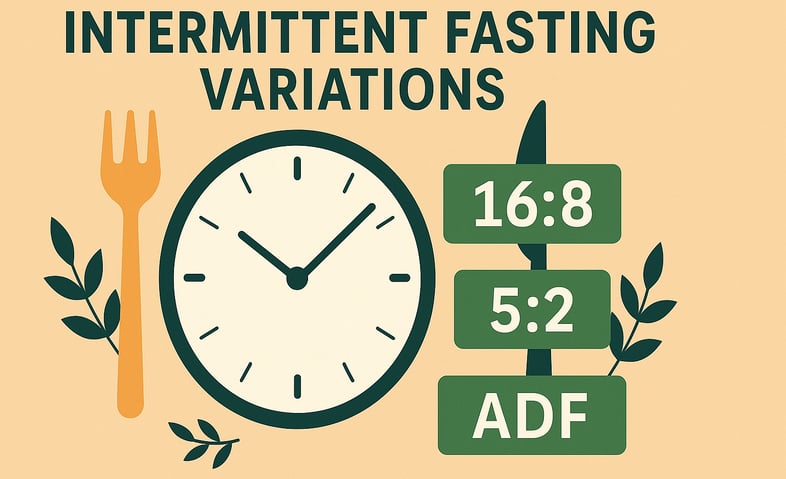Intermittent Fasting Methods Compared: 16:8, 5:2, and ADF Explained
Discover the health benefits, challenges, and best use cases of 16:8, 5:2, and alternate-day fasting. Learn which intermittent fasting method fits your lifestyle.
5/9/20253 min read


Intermittent Fasting Variations and Their Effects
Which Fasting Style Is Right for Your Body and Lifestyle?
Intermittent fasting (IF) has moved far beyond trend status — it’s now one of the most researched and personalized ways to improve metabolic health, manage weight, and potentially extend lifespan.
But here’s what a lot of people miss: intermittent fasting isn’t one-size-fits-all.
From the popular 16:8 schedule to more structured plans like the 5:2 diet or alternate-day fasting, each method comes with its own benefits, trade-offs, and lifestyle demands. Some are better for beginners. Others require more structure or discipline.
In this article, we’ll break down three of the most widely practiced intermittent fasting styles:
16:8 Time-Restricted Eating
The 5:2 Diet
Alternate-Day Fasting (ADF)
We'll dive into the research, share insights from health experts, and help you figure out which approach works best based on your goals, energy needs, and daily routine. You’ll also find a few science-backed tools placed throughout the article to support your fasting experience without overcomplicating things.
1. 16:8 Time-Restricted Eating
Eat during an 8-hour window, fast for 16
Probably the most beginner-friendly method, the 16:8 fasting protocol means you eat all your meals within an 8-hour window — for example, between 12 p.m. and 8 p.m. — and fast the other 16 hours, mostly during sleep.
Health Outcomes:
Insulin Sensitivity: Research in Cell Metabolism shows improved insulin markers and lower blood sugar fluctuations
Inflammation Reduction: A 2021 study found time-restricted eating reduced inflammatory cytokines linked to metabolic disease
Weight Management: Many find it effective for fat loss without feeling overly restricted
Challenges:
Requires adjustment for morning exercisers or breakfast lovers
Energy dips can happen if nutrient timing isn’t dialed in
LMNT Electrolyte Drink Mix
During a fast, electrolytes matter. LMNT helps you stay hydrated and energized without sugar or breaking your fast.
[View on Amazon]
2. The 5:2 Diet
Eat normally 5 days, restrict calories 2 days
With the 5:2 approach, you eat normally for five days a week, and on two non-consecutive days, limit your intake to 500–600 calories.
Health Outcomes:
Weight Loss: A British Journal of Nutrition meta-analysis found 5:2 dieters lost an average of 7–11 pounds over 10–12 weeks
Improved Cardiovascular Health: Participants saw drops in blood pressure, cholesterol, and inflammation markers
Hormonal Reset: May improve leptin and ghrelin balance, helping manage hunger
-Challenges:
The low-calorie days can feel difficult, especially for those with high activity levels
Social plans or busy schedules may interfere with consistency
Fasting or cutting carbs? These zero-sugar drops help you stay hydrated and energized by replenishing key electrolytes like sodium, magnesium, and potassium. Clean, paleo-friendly, and designed to support energy, focus, and recovery — without breaking your fast.
[View on Amazon]
3. Alternate-Day Fasting (ADF)
Fast every other day
This more advanced method alternates fasting days (usually 500 calories) with regular eating days.
Health Outcomes:
Rapid Fat Loss: ADF has shown higher average fat loss than 16:8 in clinical studies
Blood Sugar Control: A 2023 review in Nutrients highlighted ADF’s positive effects on glucose regulation in both diabetics and non-diabetics
Longevity Signals: Some animal and early human studies show fasting every other day may activate longevity-linked genes
-Challenges:
May be hard to sustain socially or emotionally long-term
Some people experience energy crashes on fast days without proper prep
The Complete Guide to Fasting by Dr. Jason Fung
This book walks through every major IF method, shares science-backed protocols, and offers practical, relatable advice — ideal for anyone exploring ADF or more structured approaches.
[View on Amazon]
Final Thoughts: So Which One Is Best?
There’s no universal “best” fasting style — the right one is the one you can stick with.
If you’re new to fasting, 16:8 is a great low-friction starting point.
If you want flexibility and structure, 5:2 lets you adapt your week.
If you’re after aggressive metabolic results and can manage stricter discipline, ADF might be the push you need.
The real key: support your fasting with proper hydration, nutritional awareness, and mindset tools that reduce the mental strain.
FITNESS
Nutrition
WellnesS
info@movebetterco.com
© 2025. All rights reserved | Privacy Policy | Terms & Conditions